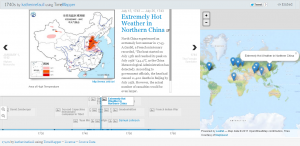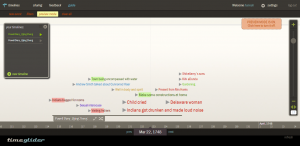Last week, we learned about the concept of contextual research and worked with two digital humanities tools, Time Mapper and Timeglider.

I’m really interested in Time Mapper, which shows readers the locations, time, images and courses of events. As Grafton pointed out, “graphic history” is a remarkable idea. From the vivid reconstructive image of Yuan Ming Garden, readers can see how extravagant the palace was. The image of a church in Tibet is also illuminating, showing readers how catholic integrated with Tibetan culture. Moreover, when I was in high school, I learned about Chinese history in a semester and European history in another semester, so I did not have a holistic and global view of history. For example, I only knew China exported lots of goods to Middle East and Europe through the Silk Road in Tang dynasty, but I did not know what happened in those region at that time. However, looking at the map of Time Mapper, we can interpret the interactions between different regions.

Despite all the advantages of Time Mapper, there are some important information of events that only Timeglider can revealed. According to Grafton, “Annals make no distinction between natural occurrences and human acts; they give no indication of cause and effect; no entry is given more priority than another.” Time glider is a “detailed” annals, showing events of specific dates (and even seconds) instead of years. It does make distinction between natural occurrences and human acts because the editors can mark natural occurrences in one color and human acts in another color. For example, in my Timeglider of Powell Diary, I marked Powell’s interactions with Indians in red, his housework in green, and his contacts with Moravians in blue. Also, it does show readers which events are more significant. In my Timeglider, the important events are larger than the others. Admittedly, it doesn’t indicate the causes and effects of the events, but it does imply. For example, if there are two events on the Timeglider, storm at night and power outage in the morning, readers can interpret that the power outage might be caused by the storm. However, the storm and power outrage do not have enough contents to create slides of Time Mapper. Hence, Time Mapper is not a wise choice for representing causalities.

Both Time Mapper and Timeglider need improvements. In his book, Grafton wrote, “Historical narrative is not linear. It moves backward and forward making comparisons and contrasts, and branches irregularly following plots and subplots. ” Actually, history is not linear, either. A historical events might lead to two or three events. Likewise, an events might be caused by a few events. Neither time mapping nor time glider represent such relations. It would be better if editors can create branches in Time Mapper or Timeglider.
Comments
3 responses to “Working with Time”
I liked how you went in depth to describe why you preferred TimeMapper opposed to Timeglider, as it made your blog post more interesting and personal. You also did a great job providing examples for both your Timeglider and TimeMapper research. I agree with you on the fact that both of these applications, although very useful, do not provide narratives nor do they represent connections between certain historical events.
I really like your opinion that neither time mapper nor time glider is perfect when representing history. They are not able to show connections between events well. However, I don’t think they can be improved. History is not a linear concept but time moves linearly. The idea of visualizing time limits these tools. They can hardly be improved but we can use them in their comfort zone.
I agree with you about how TimeMapper is a more beneficial tool for putting events into chronological order. In addition, I agree with you that TimeMapper is more personal and useful because it allows one to see the location, time, and images of each event unlike TimeGlider. Although I do agree with Grafton when he states that “time is not linear” I believe that neither TimeMapper or TimeGlider need improvements. I believe that both of these applications play a certain role and should be used only to get a brief chronological overview of historical events and texts.